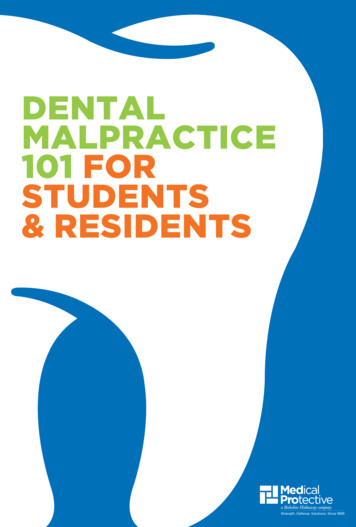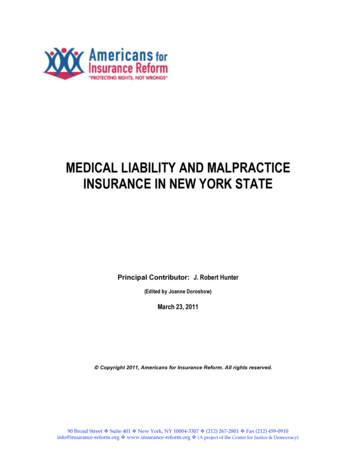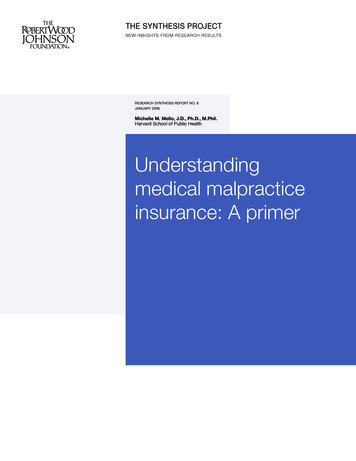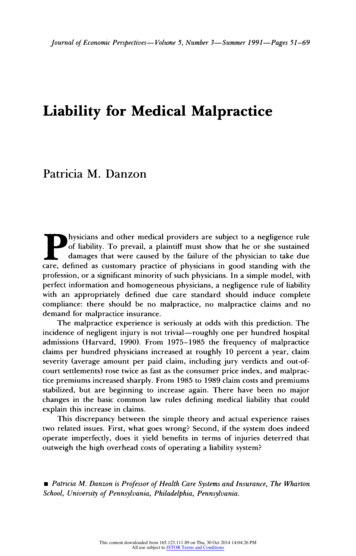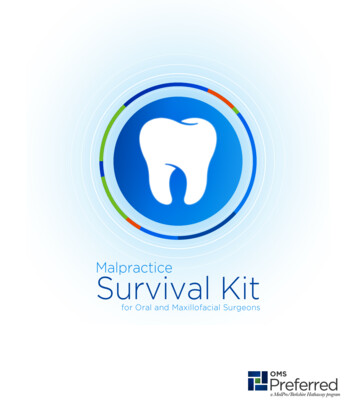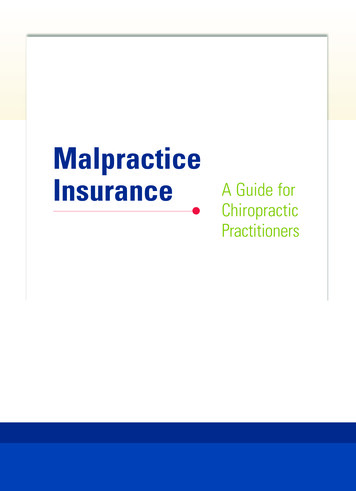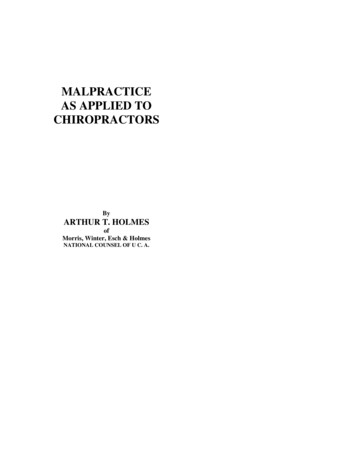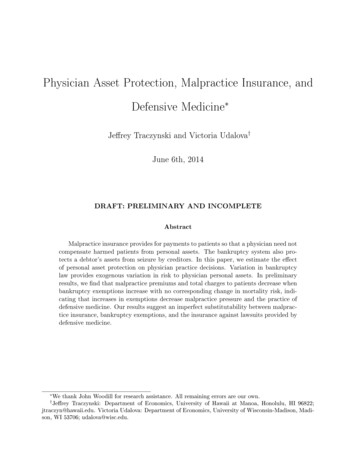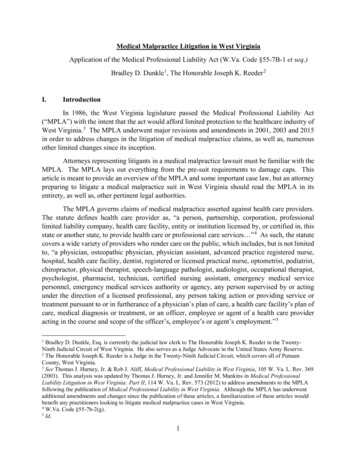
Transcription
Medical Malpractice Litigation in West VirginiaApplication of the Medical Professional Liability Act (W.Va. Code §55-7B-1 et seq.)Bradley D. Dunkle 1, The Honorable Joseph K. Reeder 2I.IntroductionIn 1986, the West Virginia legislature passed the Medical Professional Liability Act(“MPLA”) with the intent that the act would afford limited protection to the healthcare industry ofWest Virginia. 3 The MPLA underwent major revisions and amendments in 2001, 2003 and 2015in order to address changes in the litigation of medical malpractice claims, as well as, numerousother limited changes since its inception.Attorneys representing litigants in a medical malpractice lawsuit must be familiar with theMPLA. The MPLA lays out everything from the pre-suit requirements to damage caps. Thisarticle is meant to provide an overview of the MPLA and some important case law, but an attorneypreparing to litigate a medical malpractice suit in West Virginia should read the MPLA in itsentirety, as well as, other pertinent legal authorities.The MPLA governs claims of medical malpractice asserted against health care providers.The statute defines health care provider as, “a person, partnership, corporation, professionallimited liability company, health care facility, entity or institution licensed by, or certified in, thisstate or another state, to provide health care or professional care services ” 4 As such, the statutecovers a wide variety of providers who render care on the public, which includes, but is not limitedto, “a physician, osteopathic physician, physician assistant, advanced practice registered nurse,hospital, health care facility, dentist, registered or licensed practical nurse, optometrist, podiatrist,chiropractor, physical therapist, speech-language pathologist, audiologist, occupational therapist,psychologist, pharmacist, technician, certified nursing assistant, emergency medical servicepersonnel, emergency medical services authority or agency, any person supervised by or actingunder the direction of a licensed professional, any person taking action or providing service ortreatment pursuant to or in furtherance of a physician’s plan of care, a health care facility’s plan ofcare, medical diagnosis or treatment, or an officer, employee or agent of a health care provideracting in the course and scope of the officer’s, employee’s or agent’s employment.” 5Bradley D. Dunkle, Esq. is currently the judicial law clerk to The Honorable Joseph K. Reeder in the TwentyNinth Judicial Circuit of West Virginia. He also serves as a Judge Advocate in the United States Army Reserve.2The Honorable Joseph K. Reeder is a Judge in the Twenty-Ninth Judicial Circuit, which covers all of PutnamCounty, West Virginia.3See Thomas J. Hurney, Jr. & Rob J. Aliff, Medical Professional Liability in West Virginia, 105 W. Va. L. Rev. 369(2003). This analysis was updated by Thomas J. Hurney, Jr. and Jennifer M. Mankins in Medical ProfessionalLiability Litigation in West Virginia: Part II, 114 W. Va. L. Rev. 573 (2012) to address amendments to the MPLAfollowing the publication of Medical Professional Liability in West Virginia. Although the MPLA has underwentadditional amendments and changes since the publication of these articles, a familiarization of these articles wouldbenefit any practitioners looking to litigate medical malpractice cases in West Virginia.4W.Va. Code §55-7b-2(g).5Id.11
II.Background and History of the MPLAAs noted above, the MPLA was originally passed in 1986 as an attempt to balance therising costs of medical insurance coverage with the need to assure that the citizens of West Virginiaare protected in the event they suffer death or injury as a result of professional negligence. 6 Withmedical costs rising and the state facing a potential crisis as doctors fled the high costs ofmalpractice insurance, the State hoped that reform, such as the MPLA, could curb these costs,primarily through damage caps 7 for medical malpractice verdicts. 8In addition to the noneconomic damage cap, the MPLA implemented additional safeguardsto protect against the filing of frivolous claims or defenses including the incorporation of expertwitness requirements both in the pre-suit requirements and to prove liability in the case-in-chief. 9The lack of expert review prior to filing of a medical malpractice suit was identified years beforethe implementation of the MPLA as a driving factor in the number of frivolous medical malpracticeclaims in the State, but the policing of these matters was left to the judicial system. 10The MPLA provided assistance to the courts by creating pre-suit requirements, as well as,outlining the procedure for litigating a medical malpractice claim. Since its passage, the MPLAhas underwent a number of modifications with major changes in 2001, 2003, and 2015 with variousminor adjustments made intermittently. 11 In 2015, the legislature once again heavily amended theMPLA.III.Theories of LiabilityIn order to litigate a medical malpractice claim, an attorney must establish that there is infact a claim to be litigated. The MPLA provides the elements of proof for medical malpracticeclaims in W.Va. Code §55-7B-3.a.Deviation from the Standard of CareAs with other negligence based cases, medical malpractice claims require the plaintiff toprove duty, breach, and causation in order to show entitlement to damages. Under a theory ofW.Va. Code §55-7B-1 (2015).The 1986 MPLA stated, “damages for noneconomic loss shall not exceed one million dollars and the jury may beso instructed.” W.Va Code §55-7B-8 (1986).8See Franklin D. Cleckley and Govind Hatiharan, A Free Market Analysis of the Effects of Medical MalpracticeDamage Cap Statutes: Can We Afford to Live with Inefficient Doctors?, 94 W. Va. L. Rev. 11 (1991).9Id. at 44.10See Michael J. Farrell, The Law of Medical Malpractice in West Virginia, 82 W. Va. L. R. 251, 284 (1979). Priorto the implementation of the MPLA, Michael J. Farrell conducted an extensive search of medical malpracticelitigation in West Virginia in which he noted, “[t]he frequency of malpractice cases being filed without the benefit ofa prelitigation expert report in support of the plaintiff’s claim is appalling. Our courts have responded correctly tothis situation by granting summary judgment to defendants unless the plaintiff can produce an expert witness withina reasonable time after the filing of the suit and opportunity for discovery.” Id.11In Medical Professional Liability Litigation in West Virginia: Part II, Thomas J. Hurney, Jr. and Jennifer M.Mankins outline “three stages” of the MPLA, and provide an overview of the 1986 enactment as MPLA I, the 2001amendments as MPLA II, and the 2003 amendments as MPLA III. Considering the changes to the code in 2015, the2015 amendments would likely be considered MPLA IV by those authors. A reading of this article provides anexcellent background on the MPLA’s history.672
deviation from the standard of care, a plaintiff bringing suit under this theory of liability must showthat the health care provider both deviated from the relevant standard of care and that the deviationwas the proximate cause of the injury or death. 12 The plaintiff carries the burden of “provingnegligence and lack of skill on the part of the physician proximately caused the injuries suffered,”“ a claim of medical malpractice must be supported by expert testimony.” 13 Typically, mostmedical malpractice claims are asserted under the deviation from the standard of care theory.W.Va. Code §55-7B-3(a) provides the following elements under this theory:(1) The health care provider failed to exercise that degree of care,skill and learning required or expected of a reasonable, prudenthealth care provider in the profession or class to which the healthcare provider belongs acting in the same or similar circumstances;and(2) Such failure was a proximate cause of the injury or death. 14Practicing medicine with the degree of care, skill and learning required of a reasonable,prudent health care provider does not require that a health care provider makes no mistakes orpractice medicine with the highest possible degree of skill. The standard of care for medicalmalpractice cases is an objective standard based on how a reasonable health care provider wouldperform. 15 As noted in the West Virginia Pattern Jury Instructions for Civil Cases “[t]he standardof care is a reasonable standard [providers] are not held to the highest level of medical care, andare not required to guarantee or to achieve good results, they are required to comply withreasonable standard within the medical community.” 16In other words, a physician is not expectedto be perfect.The provider must meet an objective, national standard of care. West Virginia adopted anational standard of care before the MPLA was enacted. The “locality rule” in medical malpracticecases was abolished in 1986 by the West Virginia Supreme Court of Appeals. 17 The abolishmentof the “locality rule” comes from a belief that “doctors have substantially similar backgrounds interms of education, training, and continuing exposure to medical information,” as such, “the moreuniform, or certainly comparable, availability of medical knowledge and techniques” eliminatesthe needs that experts be familiar with any locality’s particular practices. 18 Therefore, whether aDellinger v. Pediatrix Medical Group, P.C., 232 W.Va. 115, 123, 750 S.E.2d 668, 677 (2013).Bellomy v. U.S., 888 F.Supp, 760, 764 (1995), citing to Hicks v. Chevy, 178 W.Va. 118, 121, 358 S.E.2d 202, 205(1987); Syllabus Point 2, Totten v. Adongay, 175 W.Va. 63414W.Va. Code §55-7B-3(a).15Pleasants v. Alliance Corp. 209 W.Va. 39, 49, 543 S.E.2d 320, 330 (2000).16West Virginia Pattern Jury Instructions for Civil Cases, 2017 edition, reporters Tom Hurney, Esq. and PaulFarrell, Esq., reviewers Don Sensabaugh, Esq. and Justice Menis E. Ketchum.17Paintiff v. City of Parkersburg, 176 W.Va. 469, 470, 345 S.E.2d 564, 565 (1986). The Supreme Court of Appealsof West Virginia clearly abolished the locality rule in West Virginia through this decision finding that the evolutionof West Virginia jurisprudence had eroded the rule.18Walker v. Sharma, 221 W.Va. 559, 565, 655 S.E.2d 775. 781 (2007) analyzing the holdings from Paintiff v. Cityof Parkersburg, 176 W.Va. 469, 470, 345 S.E.2d 564, 565 (1986).12133
doctor is practicing in a metropolitan large hospital or a rural health clinic, a certain baselinestandard of care exists.To establish a breach of the standard of care, the parties will need to employ expertwitnesses to prove medical negligence or lack of professional skill. 19 Qualifying an expert in amedical malpractice case presents its own challenges 20, but the MPLA requires, “[t]he applicablestandard of care and a defendant’s failure to meet the standard of care, if at issue, shall beestablished by the plaintiff by testimony of one or more knowledgeable, competent expertwitnesses if required by the court.” 21Establishing a breach of the standard of care does not prove liability, the plaintiff must alsoestablish that the breach was the proximate cause of the alleged harm. 22 The plaintiff must showthat the breach of the standard of care committed by the health care provider is “‘that cause whichin actual sequence, unbroken by any independent cause, produced the wrong complained of,without which the wrong would not have occurred.’” 23 Establishing the causal connection betweenthe acts of the health care provider and the injury alleged are typically fact-based issues thatbecome questions for the jury. 24 The plaintiff does not have to show that the health care provider’sactions (or inactions) were the sole cause of the harm, only that the “‘breach of a particular dutyof care was a proximate cause of the plaintiff’s injury, not the sole proximate cause.’” 25A showing that the standard of care was breached or that the actions of the health careprovider were the proximate cause of the alleged injuries is insufficient. In the end, the plaintiffbears the burden of proving both negligence and that such negligence was a proximate cause ofthe alleged injury. 26 Proving the link is essential for success.b.“Loss of Chance” TheoryPlaintiffs in medical malpractice claims have an alternative method to establish proximatecause in the “loss of chance” theory. Under this theory, the plaintiff contends “that the health careprovider’s failure to follow the accepted standard of care deprived the patient of a chance ofrecovery or increased the risk of harm to the patient which was a substantial factor in bringingabout the ultimate injury to the patient.”27 Additionally, the plaintiff is required to “prove, to areasonable degree of medical probability, that following the accepted standard of care would haveresulted in a greater than twenty-five percent chance that the patient would have had an improvedrecovery or would have survived.” 28Roberts v. Gale, 149 W.Va. 166, 173, 139 S.E.2d 272 (1964).See Section VI regarding expert witnesses herein.21W.Va. Code §55-7B-7(a).22W.Va. Code §55-7B-3(a)(2).23Mays v. Chang, 213 W.Va. 220, 224, 579 S.E.2d 561, 566 (2003) quoting Webb v. Sessler, 135 W.Va. 341, 63S.E.2d 65 (1950).24Id.25Id. See also Stephens v. Rakes, 235 W.Va. 555, 565, 775 S.E.2d 107, 117 (2015).26Dellinger v. Pediatrix Mediccal Group, P.C., 232 W.Va. 115, 124, 750 S.E.2d 668, 677 (2013); see also Syl. Pt. 4Short v. Appalachian OH-9, Inc., 203 W.Va. 246, 507 S.E.2d 124 (1998).27W.Va. Code §55-7B-3(b).28Id.19204
The “loss of chance” theory does not relieve the plaintiff of the use of experts to establishthe standard of care, but shifts the expert’s focus from injury due to breach to showing that thefailure to utilize a treatment (or the utilization of a treatment) resulted in a greater than 25% chancethat the outcome would have been improved. 29Typically, a “loss of chance” case would present itself in a failure for early diagnosis; forexample, a doctor’s failure to diagnose cancer results in the patient facing a significantly worseprognosis. 30 The plaintiff does not have to prove a guaranteed recovery or improved outcome,only that the preponderance of the evidence indicates the plaintiff was deprived of a 25% or greaterchance of an improved outcome. 31IV.Statute of LimitationsA two-year statute of limitations is established for medical malpractice cases under theMPLA. 32 The two year time limit begins on the date of injury, or “within two years of the datewhen such person discovers, or with the exercise of reasonable diligence, should have discoveredsuch injury, whichever last occurs: Provided, That in no event shall any such action be commencedmore than ten years after the date of injury.” 33a.Commencement of Statute of LimitationsAs noted above, medical malpractice cases have a two year statute of limitations, whichbegins when the plaintiff discovers, or, with reasonable diligence, should discover the allegedinjuries. 34 This is not to say that the plaintiff needs to understand the full extent or exact nature ofthe alleged injuries at the time counsel is sought, only that “something went wrong.” 35For minors, any action brought by or on behalf of a minor who was under the age of ten atthe time of the injury shall be commenced either within two years or prior to the minor’s twelfthbirthday, whichever provides the child with more time. 36 Therefore, a child who is four at the timeof the injury would have until her twelfth birthday, since she would be six after two years andwould have a longer period waiting until her twelfth birthday. 37The MPLA contains a statute of repose that cuts off actions that are not filed within ten(10) years regardless of the nature of injury. 38 In a typical medical malpractice case, a plaintiffshould discover with reasonable diligence the possible injury within the two year statute oflimitations; however, certain injuries may not present for an extended time or may be concealed.See Lambert v. United States, Not Reported in F.Supp.3d, 2016 WL 6782748 (November 15, 2016).Thomas J. Hurney, Jr. and Jennifer M. Mankins, Medical Professional Liability Litigation in West Virginia: PartII, 114 W. Va. L. R. 573, 584 (2012).31See Bunner v. United States, Not Reported in F. Supp.3d, 2016 WL 1261151 (March 30, 2016).32W.Va. Code §55-7B-4(a).33Id.34Parsons v. Herbert J. Thomas Memorial Hospital Association, Not Reported in S.E.2d, 2017 WL 5513620(November 17, 2017).35Id at 4.36W.Va. Code §55-7B-4(c).37Cartwirght v. McComas, 223 W.Va. 161, 166, 672 S.E.2d 2997, 302 (2008).38W.Va. Code §55-7B-4(a).29305
The statute of repose acts as an outer limit on claims and bar the right of the plaintiff to bring theaction. 39There is another way the two statute of limitations may be tolled. The statute of limitationsare tolled if “the health care provider or its representative has committed fraud or collusion byconcealing or misrepresenting material facts about the injury.” 40 In the event of such misconduct,the statute of limitations is tolled for the period of misconduct. 41b.Discovery RuleThe discovery rule delays the start of the statute of limitations. The Supreme Court ofAppeals of West Virginia has provided guidance on when the statute of limitations is delayedunder the discovery rule:In tort actions, unless there is a clear statutory prohibition to itsapplication, under the discovery rule the statute of limitations beginsto run when the plaintiff knows, or by the exercise of reasonablediligence, should know (1) that they plaintiff has been injured, (2)the identity of the entity who owed the plaintiff a duty to act withdue care, and who may have engaged in conduct that breached thatduty, and (3) that the conduct of that entity has a causal relation tothe injury. 42Under the discovery rule, “the statute of limitations is tolled until a claimant knows or byreasonable diligence should know of his claim.” 43 In the MPLA, the legislature codified thediscovery rule in medical malpractice claims. Rather than include a strict two year statute oflimitations, the MPLA recognizes that certain injuries may be latent and provides that the statuteof limitations may not start until “ when such person discovers, or with the exercise of duediligence, should have discovered ” the potential malpractice. 44The discovery rule comes into play where a patient’s discovery of an injury is at issue.This is ultimately a fact based investigation that becomes a question for the jury. 45 It may bereasonable for a patient to suspect an injury due to medical negligence following a procedure;however, certain injuries may present later.Logically, the discovery rule does have an outer limit. The tolling of the statute of limits,which is available due to the discovery rule, is no longer available after the death of the plaintiff.46Upon death, any injuries suffered by the patient would be discovered. 4751 Am. Jur. 2d Torts §87 (2018).W.Va. Code §55-7B-4(d).41Id.42Gaither v. City Hosp., Inc., Syl. Pt. 4, 199 W.Va. 706, 487 S.E.2d 901 (1997).43Id. at 711.44W.Va. Code §55-7B-4(a).45Gaither at Syl. Pt. 5.46Williams v. CMO Management, LLC, 239 W.Va. 530, , 803 S.E.2d 500, 507 (2016).47See Id.39406
V.Pre-litigation Requirementsa.Notice of Claim and Screening Certificate of MeritBefore filing a medical malpractice claim, the plaintiff must comply with certain statutoryrequirements. Prior to serving the complaint, the plaintiff must provide the health care providerwith a Notice of Claim and Screening Certificate of Merit. These requirements are not meant tolimit available remedies to a plaintiff, rather the pre-litigation requirements are “(1) to prevent themaking and filing of frivolous medical malpractice claims and lawsuits; and (2) to promote thepre-suit resolution of non-frivolous medical malpractice claims ” 48The Notice of Claim must be provided at least thirty (30) days prior to the filing of thecomplaint to the provider via certified mail, return receipt requested. 49 The plaintiff must provideeach possible health care provider defendant with a separate Notice of Claim. The Notice of Claimmust include “a statement of the theory or theories of liability upon which a cause of action maybe based, and a list of all health care providers and health care facilities to whom notices of claimare being sent, together with a screening certificate of merit.” 50 Additionally, a recent change tothe MPLA requires, “agents, servants, employees, or officers of the health care facility beidentified by area of professional practice or role in the health care at issue ” if the claim ofmedical malpractice is based on “the act or failure to act of agents, servants, employees, or officersof the health care facility ” 51The Notice of Claim tolls the statute of limitations to allow a litigant to prepare the case.Upon mailing of the Notice of Claim,[A]ny statute of limitations applicable to a cause of action against ahealth care provider upon whom notice was served for allegedmedical professional liability shall be tolled from the date of mail ofa notice of claim to thirty days following receipt of a response to thenotice of claim, thirty days from the date a response to the notice ofclaim would be due, or thirty days from the receipt by the claimantof written notice from the mediator that the mediation has notresulted in a settlement of the alleged claim and that mediation isconcluded, whichever last occurs. 52Litigants should remain conscious of the two-year statute of limitations, but understand that thestatute does provide some leeway in allowing the tolling of the statute of limitations from the timethe Notice of Claim is sent.Roy v. D’Amato, 218 W.Va. 692, 697, 629 S.E.2d 751, 756 (2006) citing Hinchman v. Gillette, 217 W.Va. 378,384, 618 S.E.2d 387, 393 (2005).49W.Va. Code §55-7B-6(b). 2019 West Virginia Laws S.B. 510, which is effective on May 29, 2019, modified thissection of the statute. The update adds the requirements that defendants be identified by area of professionalpractice.50Id.51W.Va. Code §55-7B-6(b).52W.Va. Code §55-7B-6(i)(1).487
A Screening Certificate of Merit needs to accompany the Notice of Claim provided to eachdefendant. As with the Notice of Claim, a separate Screening Certificate of Merit must be providedto each alleged defendant. The Screening Certificate of Merit must be executed under oath by ahealth care provider qualified as a an expert under the West Virginia Rules of Evidence who hasno existing financial interest in the underlying claim 53, and needs to specifically state: “(A) Thebasis for the expert’s familiarity with the applicable standard of care; (B) the expert’squalifications; (C) the expert’s opinion as to how the applicable standard of care was breached;and (D) the expert’s opinion as to how the breach of the applicable standard of care resulted indeath; and (E) a list of all medical records and other information reviewed by the expert executingthe screening certificate of merit.” 54The Notice of Claim and Screening Certificate of Merit are meant to provide notice of thenature and extent of the claims against a health care provider, and assure that the claims aremerited. However, the MPLA does provide a vehicle for a plaintiff who believes the nature of hisor her claim is such that an expert certification is unnecessary. A plaintiff who “believes that noscreening certificate of merit is necessary because the cause of action is based upon a wellestablished legal theory of liability which does not require expert testimony supporting breach ofthe applicable standard of care ” may file “a statement specifically setting forth the basis of thealleged liability of the health care provider in lieu of a screening certificate of merit.” 55Actually utilizing the exception to the Screening Certificate of Merit has presented somedifficulties. In Westmoreland v. Vaidya, 222 W.Va. 205, 664 S.E.2d 90 (2008), a familypractitioner underwent a cystoscopy, in which a temporary stent was removed from his ureter. Dr.Westmoreland alleged that he withdrew his consent for the procedure, but Dr. Vaidya continuedresulting in Dr. Westmoreland becoming permanently injured and disfigured. Dr. Westmorelandfiled a claim against Dr. Vaidya alleging medical malpractice, civil battery, slander, and fraud. Inhis “notice of intent to bring suit”, Dr. Westmoreland, pro se, stated that he intended to proceedunder W.Va. Code §55-7B-6(c) stating the notice was “in lieu of [a] Certificate of Merit due to thefact that the common person would not need to have an expert verify the breech [sic] of [the]standard of care[.]” 56Dr. Westmoreland’s case was initially dismissed by the Circuit Court for failure to complywith the statutory requirements of the MPLA. 57 On appeal, the majority found that Dr.Westmoreland should have been afforded a reasonable amount of time to fulfill the pre-suitThe expert executing the Screening Certificate of Merit may be compensated for their opinions voiced in theScreening Certificate of Merit, and may participate in the matter as an expert going forward. However, they cannothave an existing interest in the underlying claim, i.e. they could not have participate in the care of the plaintiff. SeeW.Va. Code §55-7B-6(b).54W.Va. Code §55-7B-6(b) with updates from West Virginia Laws S.B. 510. The prior version of the statute did notrequire a list of the medical records and other information reviewed by the expert be provided with the ScreeningCertificate of Merit.55W.Va. Code §55-7B-6(c).56Westmoreland v. Vaidya, 22 W.Va. 205, 208, 664 S.E.2d 90, 93 (2008).57Id. at 207.538
certificate of merit requirement before his case was dismissed. 58 Justice Starcher wrote a separateconcurrence to voice his opinions regarding the procedural barriers of the MPLA, including thescreening certificate of merit, in which he stated that the pre-suit requirements of the MPLAsometimes serve as little more than “procedural humps” that “restrict, delay, or deny citizens’access to the courts.” 59 As the MPLA has developed, the procedural aspects of the act haveremained, but have continued to be refined and improved.The MPLA provides a mechanism to extend the time to obtain a screening certificate ofmerit if a claimant finds him or herself against the statute of limitations. Under §55-7B-6(d),claimants may provider the health care provider with a statement of intent to provide the screeningcertificate of merit within sixty (60) days. 60The majority of medical malpractice cases will require a Screening Certificate of Merit.Although a mechanism exists for a medical malpractice case to proceed without a ScreeningCertificate of Merit, most allegations of negligence will not fall into a “cause of action basedupon a well-established legal theory of liability which does not require expert testimony supportinga breach of the applicable standard of care ” 61 In most medical malpractice cases, liability willbe a contested issue and the Screening Certificate of Merit will be needed to help the defendantunderstand the basis for the claims in the matter.b.Hinchman ResponseA Hinchman Response affords the health care provider an early opportunity to lay out anydeficiencies or concerns that may be identified in the Screening Certificate of Merit. This initialresponse provides the opportunity to filter out frivolous lawsuits based on the pleadingrequirements of the MPLA.The Supreme Court of Appeals of West Virginia laid out the purposes of the pre-suitrequirements in Hinchman v. Gillette, 217 W.Va 378, 618 S.E.2d 387 (2005). Syllabus Point Twoof Hinchman states:Under W.Va. Code, 55-7B-6 (2003) the purposes of requiring a pre-suitnotice of claim and screening certificate of merit are (1) to prevent themaking and filing of frivolous medical malpractice claims and lawsuits; and(2) to promote the pre-suit resolution of non-frivolous medical malpracticeclaims. The requirement of a pre-suit notice of claim and screeningcertificate of merit is not intended to deny citizens’ access to the courts. 6258Id. at 212. The Court stated that a typical amount of time in situations like this one require about 30 days toremedy the deficiency.59Id. at 214.60W.Va. Code §55-7B-6(d).61W.Va. Code §55-7B-6(c).62Hinchman, Sy. Pt. 2, 217 W.Va. 378, 618 S.E.2d 387 (2005).9
Since the statute is intended to prevent frivolous claims and promote resolution of claims,the plaintiff is encouraged to obtain a Screening Certificate of Merit. Likewise, the defendants isencouraged to identify issues in the case prior to the filing of suit. 63One issue with pre-suit requirements is that there is no court with jurisdiction to rule ondeficiencies in the pre-suit requirements. 64 As a result of this, healthcare providers who receivedScreening Certificates of Merit that they believed were deficient had issues challenging thesufficiency of the Screening Certificate of Merit.In response to this issue, Hinchman modified Rule 12(e)’s approach on a motion for a moredefinite statement, so that when a healthcare provider receives a pre-suit notice of claim andscreening certificate of merit that the healthcare provider believes to belegally defective or insufficient, the healthcare provider may reply withinthirty days of the receipt of the notice and certificate with a written requestto the claimant for a more definite statement 65This request needs to lay out all the insufficiencies in the Screening Certificate of Meritand Notice of Claim identified by the healthcare provider as, “the making of a request for a moredefinite state in response to a notice of claim and screening certificate of merit preserves a party’sobjections to the legal sufficiency of the notice and certificate as to all matters specifically set forthin the request ” 66The healthcare provider must assure that all of the insufficiencies are identified in therequest as, “ all objections to the notice and certificate’s legal sufficiency not specifically setforth in the request are waived.” 67 Th
In order to litigate a medical malpractice claim, an attorney must establish that there is in fact a claim to be litigated. The MPLA provides the elements of proof for medical malpractice claims in W.Va. Code §55-7B-3. a. Deviation from the Standard of Care As with other negligence based cases, medical malpractice claims require the plaintiff to
